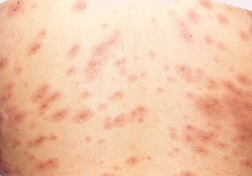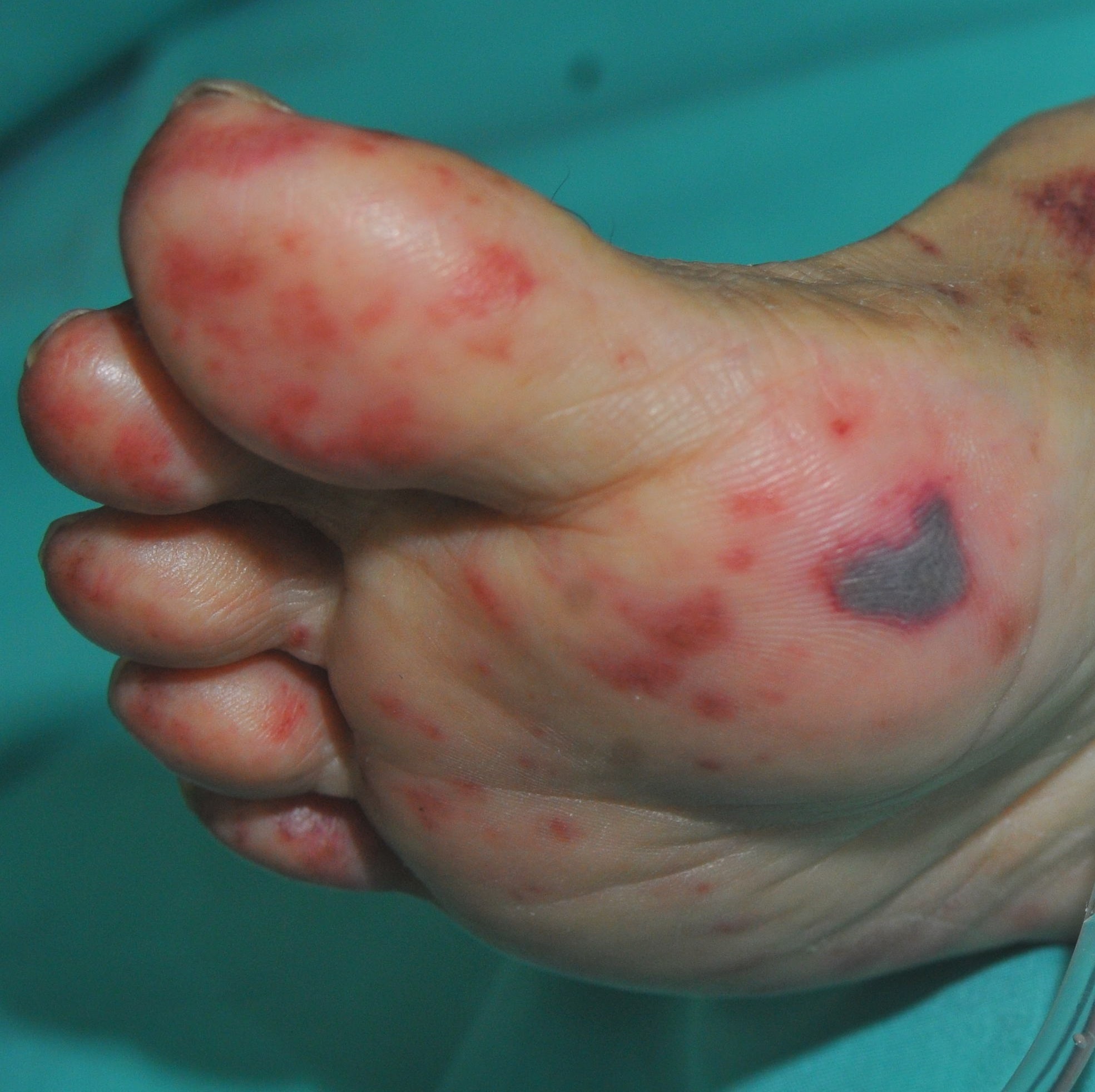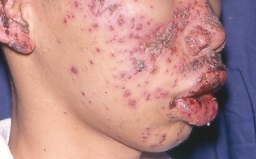Stevens-Johnson Syndrome (SJS) is a potentially serious disease that affects the immune system and typically involves the skin and mucous membranes. Its severity can range from multiple discrete spots of rash on the skin or progress to a more confluent detachment of the skin. The most severe form is called Toxic Epidermal Necrolysis (TEN). This article will not be discussing on TEN.
Stevens-Johnson Syndrome has been described worldwide in all races. However there is strong evidence that genetic predisposition plays a role in severe skin reactions to certain medications. The carriers of these genes have increased risk. However pretreatment screening is not readily available.
Signs and symptoms
A few days before the onset of rash, the following may appear first:
Flu-like symptoms consisting of fever, headache, myalgia (muscle pain), malaise (feeling easily tired), arthralgia (joint pains), sore mouth and throat, cough and burning sensation in the eyes.
As the disease progresses, the following will appear:
Multiple discrete red or purple skin lesions (Photo 1) which maybe painful and can present on the palms, soles, limbs and trunk. It will progress to form blisters (Photo 2) with involvement of mucous membranes of the mouth, nose, eyes or genialia (not all mucosae are involved). The blisters on the skin may rupture leaving denuded skin which is susceptible to secondary bacterial infection and cause scarring. The blisters involving mucous membranes easily rupture (Photo 3), causing redness, erosions or ulcers with or without slough.
The conjunctiva or cornea may be affected causing redness of the eyes due to the on-going inflammation of the eyes and in severe cases, it may cause defective or opaque cornea.
 |
 |
| Photo 1: Discrete lesions on the trunk | Photo 2: A blister on the solei |
 |
| Photo 3: Red and swollen lips with erosions |
Commmon causes of Stevens-Johnson Syndrome
There are various causes implicated and drugs (medications) are the most common cause.
- Drugs : Antibiotics are the most common drug that cause SJS, followed by analgesics, non-steroidal anti-inflammatory drugs (NSAIDs), anticonvulsants (phenytoin, carbamazepine etc.) and antigout drugs (allopurinol).
Penicillins and sulfa drugs are common antibiotics that cause SJS. Antiretroviral drugs that cause SJS include nevirapine and other non-nucleoside reverse transcriptase inhibitors. Biologics such as infliximab, etanercept and adalimumab have been reported to cause SJS. - Infections: In children infection is a more common cause of SJS than drug.
Viral infections causing SJS are Herpes simplex, HIV, Coxsackie, Influenza, Hepatitis, Mumps, Epstein-Barr virus and enteroviruses.
Bacterial infections include Group A beta-hemolytic Streptococci, Diphtheria, Mycoplasma pneumonia, Typhoid. - Malignancy: This is more often seen in SJS in elderly patients.
- Idiopathic (Unknown): Unknown cause is seen in 20-25% of cases.
When to suspect drug allergy
It is very important to be aware of drug allergy whenever a person takes any new medications or taking the medications intermittently. For some medications such as phenytoin or carbamazepine the allergy may occur after 6 months. Any individual can develop drug allergy at any point of time especially if the individual has been exposed to the medications previously. For those who are on many types of medications, the healthcare personnel and patients themselves should be aware of the possibility of drug allergy if they develop rashes.
Sometimes, in the early stage, the healthcare personnel and patients may think that they are only having flu symptoms rather than drug allergy. Withdrawal of drugs early can shorten the duration of disease, prevent the progression to severe disease, prevent complications and even death (especially if it progresses to TEN). Getting early treatment can shorten the duration of disease and prevent complications.
Some patients with HIV, systemic lupus erythematous (SLE), renal failure, liver failure, the elderly or those on multiple drugs, are at risk of developing drug allergy. Therefore, it is always important to review the more recent medications to avoid delay in stopping the causative drugs.
Treatment
Withdrawal of any agent suspected of causing the condition is critically important.
Most patients with Stevens-Johnson syndrome are treated symptomatically. Special attention is provided to ensure airway is patent, hemodynamics stable (eg: blood pressure monitoring), fluid status stable, skin care optimised and the pain is adequately controlled if necessary.
Oral lesions are managed with mouthwashes and topical anesthetics are useful in reducing pain and allowing the patient to take in fluids.
Large blisters will be aspirated and areas of denuded skin must be cleansed with astringents (eg: potassium permanganate) or use saline compresses. Large denuded areas will be covered with suitable dressings available. Patients may be started on systemic steroid if detected early within the next 24-72 hours.
Eye treatment depends on the severity. Most patients do not need treatment but some may need lubricants, topical steroids or antibiotics. If inflammation worsens certain procedures need to be carried out to prevent scaring and adhesions.
Individual lesions typically should heal within 1-2 weeks, unless secondary infection occurs. Most patients recover without sequelae.
Some may experience numerous long-term sequelae if not treated early especially eye complications such as photophobia (glaring to lights), a burning sensation in the eyes, watery eyes, a siccalike syndrome (very dry eyes) and corneal and conjunctival neovascularization (new tissue or blood vessels formation).
Prevention
Drug allergy can affect any individual and it is unpredictable. However, once a patient is diagnosed with allergy to a particular drug, it is important to avoid reexposure to the same drug.
For those at risk of developing drug allergy, it is important to limit to only drugs that are necessary.
A drug allergy card should be carried or medic alert in necklace or bracelet form should be worn by patients at all times. It is important to inform your regular doctor if a new medication is being introduced or if you are seeing the doctor for the first time.
Do not buy your own medicines if you are not familiar with them. Drugs in the same class or group may cause SJS. There are many generic drugs in the market with different brand names and they may cause the same reactions as the innovator drug that you are allergic to.
If you develop any of the symptoms and signs as previously described, discontinue the new drug or drug that you are taking intermittently and see your doctor for advice. Discontinuing the drug early may help prevent progression of the disease.
References
- French LE. Toxic epidermal necrolysis and Stevens Johnson syndrome: our current understanding. Allergol Int. Mar 2006;55(1):9-16.
- Roujeau JC. Stevens-Johnson syndrome and toxic epidermal necrolysis are severity variants of the same disease which differs from erythema multiforme. J Dermatol. Nov 1997;24(11):726-9.
- Gruchalla RS. 10. Drug allergy. J Allergy Clin Immunol. Feb 2003;111(2 Suppl):S548-59.
- Halevy S, Ghislain PD, Mockenhaupt M, et al. Allopurinol is the most common cause of Stevens-Johnson syndrome and toxic epidermal necrolysis in Europe and Israel. J Am Acad Dermatol. Jan 2008;58(1):25-32.
| Last Reviewed | : | 23 August 2019 |
| Writer/Translator | : | Datin Dr. Asmah bt. Johar |
| Accreditor | : | Datuk Dr. Roshidah bt. Baba |
| Reviewer | : | Dr. Nazatul Shima bt. Abd Rahim |







